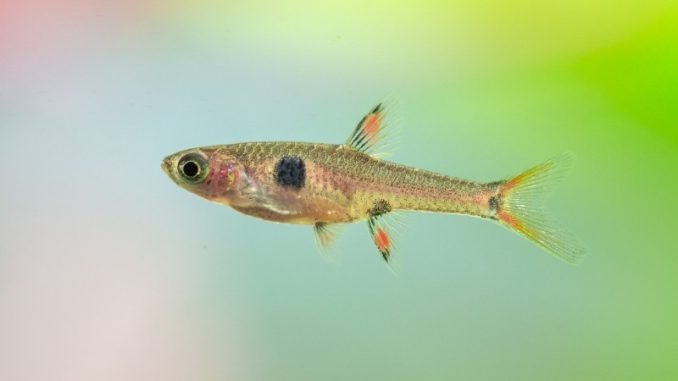
The dwarf rasbora is a small, freshwater fish of the rasboras family. Endemic to Southeast Asia, dwarf rasboras grow up to one inch and have vibrant, black dots across their bodies.
Dwarf rasboras are peaceful and timid fish that are best kept in groups of at least eight.
TABLE OF CONTENTS
Dwarf Rasbora Facts & Overview

| Scientific name | Boraras maculatus |
| Common names | Dwarf rasbora, pygmy rasbora, spotted rasbora |
| Distribution | Malay Peninsula, Thailand, Sumatra, Singapore, Indonesia |
| Size | Up to 1 inch |
| Life expectancy | 3–5 years |
| Color | Red with black splotches |
| Diet | Omnivore |
| Temperament | Peaceful, timid |
| Minimum tank size | 5 gallons |
| Temperature | 75°–79°F (24°–26°C) |
| pH | 4.5 – 6.8 |
| Hardness | 1– 5 dGH |
| Care level | Intermediate |
| Breeding | Egg scatterer |
Origin
The dwarf rasbora (Boraras maculatus) is native to Southeast Asia, in Malaysia, Thailand, Sumatra, Singapore, and Indonesia. This fish inhabits black water streams and forest rivers, where the water is slow-flowing, acidic, and densely vegetated.
Dwarf rasboras are prolific in the wild and are classified as a “least-concern species” by the International Union for Conservation of Nature (IUCN).
Dwarf rasboras are a shoaling species. The fish are more active, colorful, and comfortable in groups of eight or more. They are sensitive to water changes and can’t be kept in most community tanks due to their timid nature and small size.
Adult Size & Lifespan
A dwarf rasbora’s size varies depending on sex, genetics, and environment. Most adult dwarf rasboras grow to 0.5–0.8 inches, and the fish’s maximum size is one inch. Females are larger and have rounder bellies than males.
Dwarf rasboras live an average of 3–5 years in captivity. Appropriate tank conditions, regularly changing the water, and a nutrient-rich diet help dwarf rasboras live long and happy lives.
Availability
Dwarf rasboras are difficult to find in local pet stores. The fish are sensitive to water fluctuations and prone to stress. Buying from a reputable breeder ensures the fish is healthy and raised in appropriate conditions.
Dwarf rasboras cost $5–$8, with a school of six costing around $30. If there is no breeder in your area, consider these trustworthy online stores:
Appearance & Behavior
The dwarf rasbora is one of the smallest rasbora species. The fish is red with black spots on its body. Dwarf rasboras are peaceful and enjoy the company of their own kind, and the fish need lots of hiding spots to feel comfortable.
Colors, Patterns, Fins, and Sex Differences
Dwarf rasboras are reddish-orange with dark splotches at the center of their bodies, anal fins, and tails. The fish have rayed dorsal fins and forked-shaped tails. Male dwarf rasboras are slimmer and have bolder colors than females. Coloration and patterns vary depending on population, diet, and geographical location.
Dwarf rasboras resemble clown rasboras and were once considered the juveniles of clown rasboras. However, further research uncovered the true, individual nature of the dwarf rasbora species.
Dwarf rasboras lose their vibrant, red color when stressed. During breeding, female dwarf rasboras become noticeably plump and males gain more coloration.
Typical Behavior
Dwarf rasboras are peaceful, shoaling fish that spend most of their time hiding between plants.
The dwarf rasbora prefers to swim in the top and middle levels of the tank. These fish thrive in groups of at least eight. Kept alone, dwarf rasboras become stressed, skittish, and prone to sickness. Dwarf rasboras are diurnal, meaning they’re active in the daytime and rest at night.
Dominant male dwarf rasboras establish territories during the breeding season and can exhibit aggression to other males. A spacious tank helps curb aggressive behavior in dwarf rasboras.
Dwarf Rasbora Care & Tank Requirements
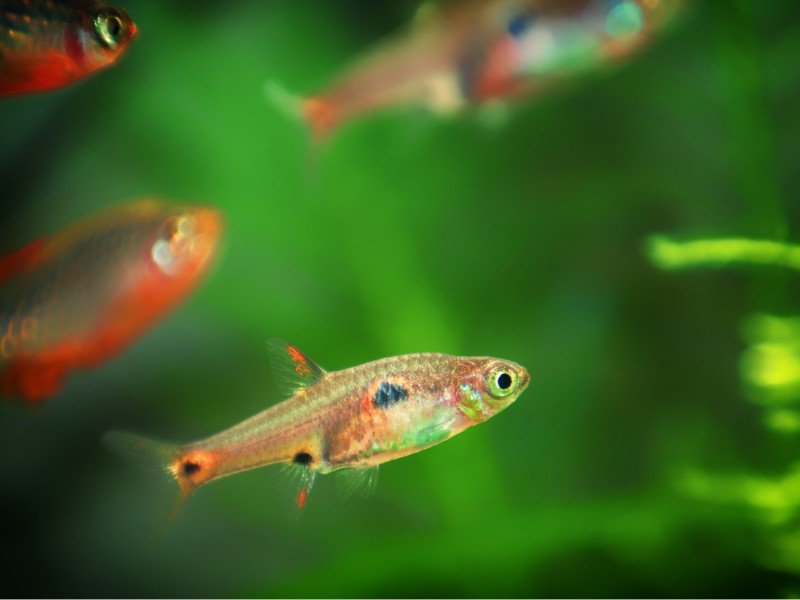
Dwarf rasboras are moderately difficult to care for. The fish’s timid nature and sensitivity to water fluctuations make it best suited for fishkeepers with experience.
Dwarf rasboras shouldn’t be kept with large or boisterous species, and the fish must be fed three times daily. Feed dwarf rasboras a varied diet including small live food, like daphnia, and baby brine shrimp.
Habitat and Tank Requirements
Dwarf rasboras thrive in slow-moving black rivers and streams. The fish’s natural environment is densely vegetated, acidic, and colored black by decaying leaves. Trees provide shade for the fish.
Replicate the dwarf rasbora’s natural habitat with soft acidic water, plants, and leaf litter.
Tank Conditions
| Water type: | Freshwater |
| Tank size: | 5 gallons minimum for eight dwarf rasboras |
| Water temperature: | 75°–79°F (24°–26°C) |
| Substrate: | Dark, sandy |
| Tank setup: | Hiding areas with plants, driftwood, and rocky caves |
| Acidity: | 4.5–6.8 pH |
| Water hardness: | Up to 5 dGH |
| Filter: | Peat filtration, to soften the water without making a strong current |
| Bubbler: | No |
| Lid: | Yes, well-fitted to prevent escape |
Dwarf rasboras thrive in a 5-gallon tank with stable water parameters, dense vegetation, and hiding spots. To house a bigger school, provide an additional two gallons of water per fish.
Water must be well-maintained for dwarf rasboras to thrive. Provide regular 25% water changes to keep the tank clean and remove excess waste. Dwarf rasboras are sensitive to water changes, so take measures to ensure water parameters remain stable.
A dark, sandy substrate best resembles the dwarf rasbora’s natural habitat, and lets the fish’s vibrant red hue shine. Vacuum the substrate monthly to prevent waste accumulation.
Dwarf rasboras are shy fish that need hiding spots to feel comfortable. Create hiding areas with plants, driftwood, and rocky caves. Incorporate plants such as milfoil throughout the aquarium.
Replicate the dwarf rasbora’s natural, black water environment with leaf litter and bogwood. Both release tannins that stain the water and keep it acidic. Replace leaf litter every few weeks to prevent the tank from becoming dirty.
A bubbler isn’t necessary. Strong or noisy bubblers scare dwarf rasboras.
Water should be soft, acidic, and kept out of harsh lighting. Keep the tank’s temperature between 75°–79°F. Avoid introducing dwarf rasboras to a biologically-immature tank. Even slight water fluctuations can cause death.
Disease
Dwarf rasboras become stressed easily, making the fish susceptible to freshwater fish diseases such as Ich, fin rot, and swim bladder disease.
Ich
Ich is an infection caused by the Ichthyophthirius multifiliis protozoan parasite. Fish with ich develop white spots on their bodies, fins, and gills. Other ich symptoms include lethargy, changes in fin coloration, and the fish rubbing itself against rough decorations. Ich is often caused by stress or poor water conditions.
Prevent ich with regular water changes and make sure to replicate the dwarf rasbora’s preferred living conditions. Treat ich by gradually increasing the water temperature to 80°–82°F.
Fin Rot
Fin rot is a bacterial infection that causes tail and fin decay and occurs when dwarf rasboras are stressed or the water’s oxygen levels are too low. Symptoms of fin rot include sluggishness, loss of appetite, and tattered, dull fins.
Fin rot is treated with prescribed antibiotics. However, dwarf rasboras are sensitive to medication, so prevention is the best method – establish stable and ideal water parameters and keep stressors at a minimum.
Swim Bladder Disease
Swim bladder disease affects the swim bladder, preventing the dwarf rasbora from maintaining buoyancy. The illness is caused by constipation, overeating, or infection. Symptoms of swim bladder disease include a swollen belly, sinking or floating near the top of the aquarium, and unusual swimming patterns.
Treat swim bladder disease by raising the tank temperature by a few degrees and not feeding the dwarf rasbora for a few days. After three days, feed the fish a broken-up small pea to help with its digestive problems. Swim bladder disease caused by infection requires medical treatment.
Tank Mates
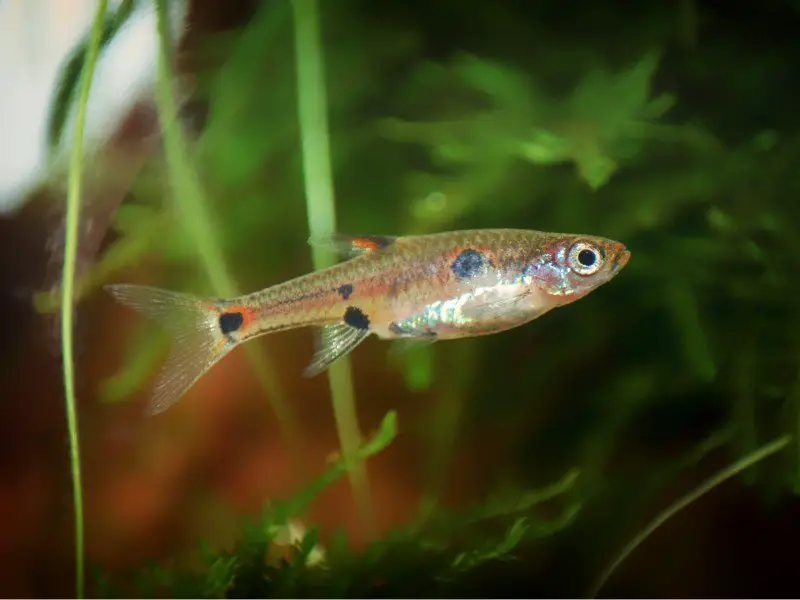
Dwarf rasboras are schooling fish that are happiest with their own kind in groups of eight or more.
Although docile, these fish aren’t suitable for most community tanks because they’re timid and sensitive, and large fish treat dwarf rasboras as prey. Avoid housing dwarf rasboras with aggressive or active fish, or fish that are quicker swimmers and eaters than dwarf rasboras, such as danios.
Ideal tank mates for a dwarf rasbora are similarly-sized, timid species including:
- Chocolate gourami
- Danionella
- Dwarf shrimp
- Espei rasbora
- Harlequin rasbora
- Otocinclus
- Pygmy cory catfish
Diet and Feeding
The dwarf rasbora is an omnivore that feeds on small insects, crustaceans, and worms in the wild. Captive dwarf rasboras eat a wide range of foods, and a nutrient-rich, varied diet helps these fish live healthy and long lives.
Feed dwarf rasboras pellets, flakes, and small live or frozen food such as daphnia and baby brine shrimp. Live and frozen food best bring out the dwarf rasbora’s coloration, but you shouldn’t feed only these foods to the fish. Provide food that is small enough to fit in the dwarf rasbora’s mouth.
Feed dwarf rasboras three times a day. Feed the fish what they can eat within two minutes, and remove leftovers to prevent waste buildup.
Breeding
Dwarf rasboras are egg scatterers and are moderately difficult to breed. Encourage spawning by feeding the fish live food and gradually increasing the water’s temperature. Males get more coloration and females start to fill out with eggs when the fish are fed appropriately.
A separate, 3-gallon breeding tank gives dwarf rasbora fry the best chance of survival. Keep the water at a pH of 5.8–6.3, the hardness between 2–3 dGH, and temperature around 79°F. Decorate the tank with fine-leafed plants such as Java moss or a spawning mop to help catch the eggs.
Avoid using a strong filtration system, which will suck in the fry. Peat filtration or a small sponge filter are safe alternatives.
One breeding tank can house two to three pairs of dwarf rasboras. Give the pairs a couple of weeks to acclimatize to the new tank.
Dominant males form territories when breeding and engage in ritual displays. Females deposit up to 50 eggs among the plants constantly during spawning. Remove the parents after spawning because dwarf rasboras don’t exhibit parental care and sometimes eat the eggs.
Fry hatch within three days and become free-swimming after 24 hours. Dwarf rasbora fry should be fed infusoria or liquid food. Move fry onto newly-hatched brine shrimp after 10 days. Avoid water changes for the first two weeks.
Should You Get a Dwarf Rasbora for Your Aquarium?
Dwarf rasboras are peaceful fish that liven up the tank with their mesmerizing shoaling behavior and vibrant coloration. The fish’s small size makes them well-suited to small tank setups.
Dwarf rasboras are best suited to experienced aquarists because the fish are timid, sensitive to water changes, and prone to stress. Keeping dwarf rasboras in groups and ensuring water parameters match the fish’s natural habitat brings out the dwarf rasbora’s coloration and confidence.
If you have a community tank with other vibrantly colored fish, dwarf rasboras might be perfect for you.

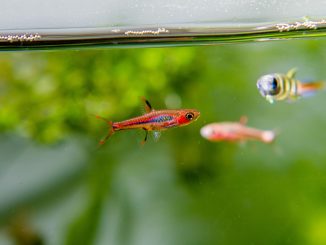
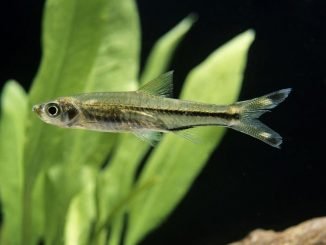
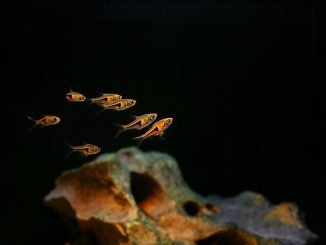
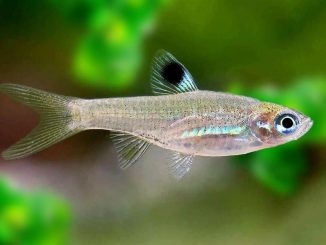
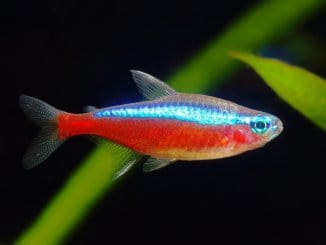
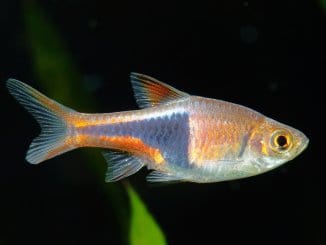
Be the first to comment